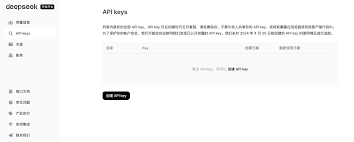 Software Tutorial
Software Tutorial
 Mobile Application
Mobile Application
 How to implement calls with Python - Deepseek Python Call Method Guide
How to implement calls with Python - Deepseek Python Call Method Guide
How to implement calls with Python - Deepseek Python Call Method Guide
Mar 12, 2025 pm 12:51 PMDeepSeek Deep Learning Library Python Call Guide
DeepSeek is a powerful deep learning library that can be used to build and train various neural network models. This article will introduce in detail how to use Python to call DeepSeek for deep learning development.
Steps to Call DeepSeek with Python
1. Install DeepSeek
Make sure that the Python environment and pip tools are installed. Install DeepSeek using the following command:
pip install deepseek
2. Import the DeepSeek library
Import the DeepSeek library in a Python script or Jupyter Notebook:
import deepseek as ds


3. Data preparation
DeepSeek supports multiple data formats. You can load data directly into memory, or use the data generator to load dynamically. For example:
from deepseek.data import load_data
train_data, train_labels = load_data('/path/to/train_data/')
test_data, test_labels = load_data('/path/to/test_data/')
4. Model construction
Define neural network models, specify their structure and parameters. For example, build a simple feedforward neural network:
model = ds.models.Sequential() model.add(ds.layers.Dense(64, activation='relu', input_shape=(784,))) model.add(ds.layers.Dropout(0.5)) model.add(ds.layers.Dense(10, activation='softmax'))
5. Model Compilation
When compiling the model, you need to specify the optimizer, loss function and evaluation metrics. For example:
model.compile(optimizer='adam', loss='categorical_crossentropy', metrics=['accuracy'])
6. Model training
Training the model using training data:
history = model.fit(train_data, train_labels, batch_size=128, epochs=20, verbose=1, validation_data=(test_data, test_labels))
7. Model evaluation
Evaluate model performance using test datasets:
score = model.evaluate(test_data, test_labels, verbose=0)
print('Test loss:', score[0])
print('Test accuracy:', score[1])
8. Callback function
DeepSeek allows adding callback functions during training to monitor training or perform specific operations. For example, use TensorBoard to visualize the training process:
from deepseek.callbacks import TensorBoard tb_callback = TensorBoard(log_dir='./logs/') model.fit(x_train, y_train, epochs=20, batch_size=128, callbacks=[tb_callback])

9. Data Enhancement
To improve model generalization capabilities, data augmentation techniques can be used to augment the training dataset. For example:
data_gen = ds.preprocessing.image.ImageDataGenerator(
rotation_range=10, width_shift_range=0.1, height_shift_range=0.1,
shear_range=0.1, zoom_range=0.1, horizontal_flip=True
)
data_gen.fit(x_train)
Then use this data generator when training the model.
Through the above steps, you can easily use Python to call DeepSeek for the development of a deep learning project. Note that /path/to/train_data/ and /path/to/test_data/ need to be replaced with your actual data path.
The above is the detailed content of How to implement calls with Python - Deepseek Python Call Method Guide. For more information, please follow other related articles on the PHP Chinese website!

Hot AI Tools

Undress AI Tool
Undress images for free

Undresser.AI Undress
AI-powered app for creating realistic nude photos

AI Clothes Remover
Online AI tool for removing clothes from photos.

Clothoff.io
AI clothes remover

Video Face Swap
Swap faces in any video effortlessly with our completely free AI face swap tool!

Hot Article

Hot Tools

Notepad++7.3.1
Easy-to-use and free code editor

SublimeText3 Chinese version
Chinese version, very easy to use

Zend Studio 13.0.1
Powerful PHP integrated development environment

Dreamweaver CS6
Visual web development tools

SublimeText3 Mac version
God-level code editing software (SublimeText3)

Hot Topics
 How to avoid risks in the turmoil in the currency circle? The TOP3 stablecoin list is revealed
Jul 08, 2025 pm 07:27 PM
How to avoid risks in the turmoil in the currency circle? The TOP3 stablecoin list is revealed
Jul 08, 2025 pm 07:27 PM
Against the backdrop of violent fluctuations in the cryptocurrency market, investors' demand for asset preservation is becoming increasingly prominent. This article aims to answer how to effectively hedge risks in the turbulent currency circle. It will introduce in detail the concept of stablecoin, a core hedge tool, and provide a list of TOP3 stablecoins by analyzing the current highly recognized options in the market. The article will explain how to select and use these stablecoins according to their own needs, so as to better manage risks in an uncertain market environment.
 Global stablecoin market value PK! Who is the gold substitute in the bear market
Jul 08, 2025 pm 07:24 PM
Global stablecoin market value PK! Who is the gold substitute in the bear market
Jul 08, 2025 pm 07:24 PM
This article will discuss the world's mainstream stablecoins and analyze which stablecoins have the risk aversion attribute of "gold substitute" in the market downward cycle (bear market). We will explain how to judge and choose a relatively stable value storage tool in a bear market by comparing the market value, endorsement mechanism, transparency, and comprehensively combining common views on the Internet, and explain this analysis process.
 Virtual Currency Stable Coins Ranking Which is the 'safe haven' in the currency circle
Jul 08, 2025 pm 07:30 PM
Virtual Currency Stable Coins Ranking Which is the 'safe haven' in the currency circle
Jul 08, 2025 pm 07:30 PM
This article will introduce several mainstream stablecoins and explain in depth how to evaluate the security of a stablecoin from multiple dimensions such as transparency and compliance, so as to help you understand which stablecoins are generally considered relatively reliable choices in the market, and learn how to judge their "hazard-haven" attributes on your own.
 Yiwu merchants start charging stablecoins
Jul 08, 2025 pm 11:57 PM
Yiwu merchants start charging stablecoins
Jul 08, 2025 pm 11:57 PM
Under the trend of Yiwu merchants accepting stablecoin payment, it is crucial to choose a reliable exchange. This article sorts out the world's top virtual currency exchanges. 1. Binance has the largest trading volume and strong liquidity, supports multiple fiat currency deposits and exits and has a security fund; 2. OKX has a rich product line, built-in Web3 wallet, and has high asset transparency; 3. Huobi (Huobi/HTX) has a long history and a huge user base, and is actively improving security and experience; 4. Gate.io has a variety of currencies, focusing on security and audit transparency; 5. KuCoin has a friendly interface, suitable for beginners and supports automated trading; 6. Bitget is known for its derivatives and order functions, suitable for users who explore diversified strategies.
 What are the types of stablecoins? What are the stablecoins in digital currency?
Jul 08, 2025 pm 11:51 PM
What are the types of stablecoins? What are the stablecoins in digital currency?
Jul 08, 2025 pm 11:51 PM
Stable coins maintain price stability by anchoring fiat currencies such as the US dollar, which are mainly divided into three categories: 1. Fiat currency collateralization types such as USDT and USDC; 2. Cryptocurrency collateralization types such as DAI; 3. Algorithm types have higher risks. Mainstream stablecoins include USDT with the highest market value and the best liquidity. USDC is known for its compliance and transparency. DAI relies on the decentralized mechanism. TUSD adopts on-chain real-time audit. BUSD is gradually withdrawing from the market due to supervision. USDP is known for its high compliance and security. Both are widely circulated on mainstream exchanges.
 A complete list of mainstream stablecoins in the currency circle. In addition to USDT, these stablecoins are more suitable for long-term holding.
Jul 08, 2025 pm 07:21 PM
A complete list of mainstream stablecoins in the currency circle. In addition to USDT, these stablecoins are more suitable for long-term holding.
Jul 08, 2025 pm 07:21 PM
In the cryptocurrency market, stablecoins are an important bridge connecting fiat currencies with digital assets. Although USDT (Tether) accounts for the largest market share, the transparency of its reserves has always attracted much attention. Therefore, it is particularly important for users seeking asset preservation and long-term holdings to understand and configure other more transparent and compliant stablecoins. This article will introduce you in detail three mainstream stablecoins besides USDT: USDC, BUSD and DAI, and analyze their respective characteristics and advantages to help you understand which one is more suitable for your long-term commitment.
 What is a stablecoin? The three major stablecoins in the currency circle
Jul 08, 2025 pm 11:54 PM
What is a stablecoin? The three major stablecoins in the currency circle
Jul 08, 2025 pm 11:54 PM
Stablecoins are cryptocurrencies with value linked to stable assets. The main types include fiat currency collateral, cryptocurrency collateral and algorithmic. The three mainstream stablecoins are Tether (USDT), USD Coin (USDC) and Dai (DAI). 1. USDT is issued by Tether, with the largest market value and the strongest liquidity, and is widely used in major exchanges; 2. USDC is issued by the Centre Alliance, known for its transparency and compliance, and has gained high trust from institutions; 3. DAI is managed by MakerDAO and is a representative of decentralized stablecoins. It maintains price stability through excessive collateral crypto assets, and is highly favored by DeFi users.
 How to iterate over two lists at once Python
Jul 09, 2025 am 01:13 AM
How to iterate over two lists at once Python
Jul 09, 2025 am 01:13 AM
A common method to traverse two lists simultaneously in Python is to use the zip() function, which will pair multiple lists in order and be the shortest; if the list length is inconsistent, you can use itertools.zip_longest() to be the longest and fill in the missing values; combined with enumerate(), you can get the index at the same time. 1.zip() is concise and practical, suitable for paired data iteration; 2.zip_longest() can fill in the default value when dealing with inconsistent lengths; 3.enumerate(zip()) can obtain indexes during traversal, meeting the needs of a variety of complex scenarios.





